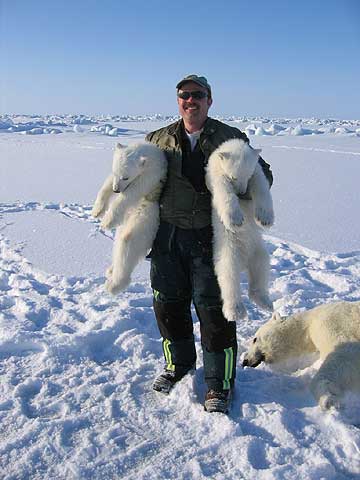 to guns for deterring bears Also found spray residue actually attracts bears March 25, 2008
Thomas S. Smith, associate professor of wildlife science, has conducted field work among bears for 16 years and has never used bear spray, although he carries it faithfully. "I wish I had more scary stories to share, but I've behaved myself," said Smith, emphasizing that caution and wisdom are the best way to prevent bear attacks. Concerned about hikers' and campers' persistent doubts that a small can of liquid pepper spray could stop half a ton of claws, muscle and teeth, Smith and colleagues analyzed 20 years of bear spray incidents in Alaska, home to 150,000 bears. He found that the spray effectively halted aggressive bear behavior in 92 percent of the cases, whether that behavior was an attack or merely rummaging for food. Of all 175 people involved in the incidents studied, only three were injured by bears, and none required hospitalization. Smith and his research team report their findings in the April issue of the Journal of Wildlife Management. "People working or recreating in bear habitat should feel confident they are safe if carrying bear spray," Smith said. Smith's previous research found that guns were effective about 67 percent of the time. Shooting accurately during the terrifying split seconds of a grizzly charge is extremely difficult, he pointed out, and his data shows that it takes an average of four hits to stop a bear. In addition, firearms are prohibited in national parks like Glacier and Denali, popular with hikers and also with bears. "Working in the bear safety arena, I even found a lot of resistance to bear spray among professionals," Smith said of the product, which retails for $30-$40. "There was no good, clean data set that demonstrated definitively that it worked, so that's why we did this research." "Tom Smith is highly respected among bear biologists, naturalists and educators. His one-on-one experience with bears in the field is an enormous resource to the bear management community," said Chuck Bartlebaugh, director of the Center for Wildlife Information, the nonprofit that runs "Be Bear Aware" and other wildlife safety campaigns. "This new study is important information that is needed by hunters, hikers or campers to understand the value of bear spray and how it can protect both people and bears." The research debunks these common misconceptions about bear spray:
Smith believes one of the primary reasons bear spray works is that it gives users a reason to stand their ground. Running is the worst response to an aggressive bear, he said, "but it's hard not to. Just picture the meanest dog in your neighborhood and multiply his size by ten-it's very hard to keep your feet from running, but bear spray gives you an option. When you stop and plant your feet, that makes them stop." This is because even though humans are much smaller than bears, the animals still view us as risky. "Having seen bears with porcupine quills in their faces, I'm sure that most bears learn at an early age that size is not a good indicator of threat," Smith said. "There's always this fear of retribution that keeps them in line. They could take any person they wanted. But they don't know that." On the rare occasions bears get close enough to warrant a spraying - about three times a year in Alaska, the study showed - the hissing sound and sight of the expanding cloud are often enough to frighten away the animal. "I have data to show that if you sprayed water, they often would run," Smith said. Counterintuitively, Smith and his team also documented 11 incidents when the residue of bear spray applied to objects like tents with the intent to repel curious bears actually backfired and attracted bears instead. Smith cautioned users against this practice and advised hikers to take their practice sprays before entering bear country. The study did not make any comparisons among various types or manufacturers of bear spray because the sample was too small to draw significant conclusions. Other findings reported in the paper include:
Smith's co-authors on the paper are Stephen Herrero, professor emeritus at the University of Calgary; Terry D. Debruyn of the National Park Service, and James M. Wilder of Minerals Management Service. The paper also relies on an earlier publication of a decade's worth of bear spray data by Herrero and Andrew Higgins. The research was funded by the U.S. Geological Survey, Alaska Science Center.
Source of News & Photograph:
Publish A Letter in SitNews Read Letters/Opinions
|
||
